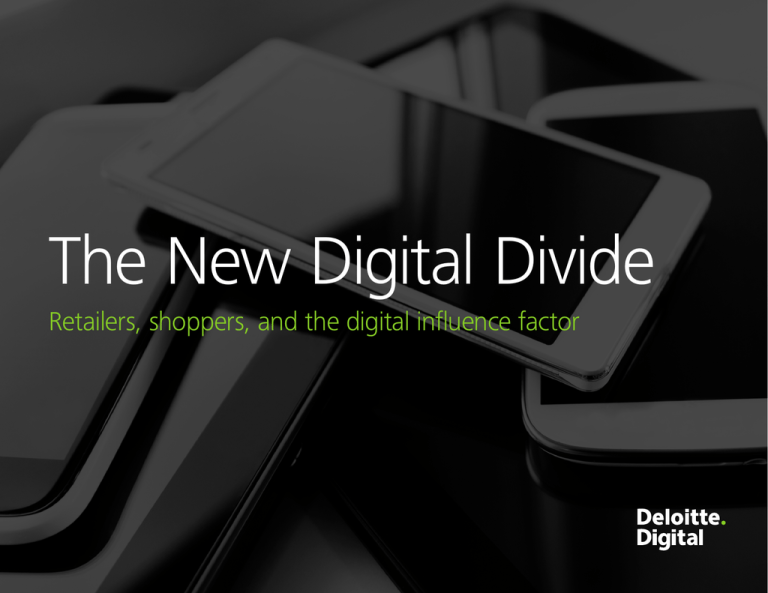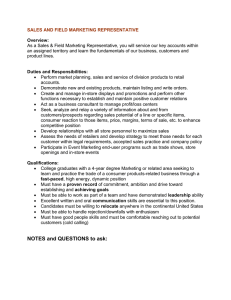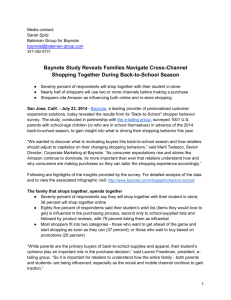
The New Digital Divide
Retailers, shoppers, and the digital influence factor
Contents
The digital influence factor ............................................................ 3
Drilling down ................................................................................ 5
Are you evaluating the right metrics? ............................................. 6
Is your brick-and-mortar strategy digital savvy? .............................. 9
Have you mastered these digital dos & don’ts? ............................. 10
Addressing the new digital divide is a business imperative ............ 13
Analysis methodology ................................................................. 15
Authors ....................................................................................... 16
The digital influence factor
It is a well-known fact that digital platforms
are changing the fundamental workings of
many businesses. Music and television have
undergone radical changes in just a few years
as mobile devices are empowering consumers
and forever changing their habits in terms of
how they listen and how they watch.
A similar, but less apparent, revolution is
underway in retail – and the speed of the
change is far greater than anything analysts
predicted just a couple of years ago. The
influence of digital devices on the shopping
journey, a dynamic Deloitte calls the ‘digital
influence factor,’ is not only shaping how
customers shop and make decisions instore. It is setting new digital expectations
of retailers in terms of how they help their
customers gather pertinent information to
make shopping decisions and purchases.
Today there is a need to measure the success
of digital investments against a new set of key
performance indicators to encourage retailers
to rethink their digital strategies and offerings
in the marketplace. The positive impact to
store traffic, conversion, order size, and loyalty
is clear and retailers have a tremendous
opportunity to harness the power of digital
(Figure 1).
3
According to recent Deloitte research, many retailers fail to leverage the potential of or meet the digital expectations of
their customers. That gap, the ‘new digital divide,’ puts at risk much more than just online shopping revenue. Clearly, this
gap is different in nature from the standard notion of ‘digital divide’ that describes socio-economic differences based
on access to information technologies. Nevertheless, for retailers, it poses a serious threat to overall revenue and a bold
challenge to the way they respond to, and anticipate, customers’ shopping habits in-store. The fact is, traditional retailers
are leaving too much money on the table and are allowing strictly online retailers to capture a growing share of revenue
that could be theirs.
Digital devices’ influence on in-store purchase behavior is growing much faster than anyone could have anticipated.
Deloitte’s research shows that today, digital technologies influence 36 percent or $1.1 trillion of in-store retail sales, and this
number will likely increase to 50 percent of in-store sales by the end of 2014.
Given this acceleration, we are at a tipping point in retail – a point where digital channels should no longer be considered
a separate or distinct business. Instead, digital is fundamental to the entire business and the entire shopping experience, in
and out of the store. As this new reality begins to have a greater impact, retailers should change dramatically the way they
think, measure, and invest in digital and address their customers’ digital needs and wants.
Yet, many retailers measure the success of their digital investments by narrowly focusing on ‘conversion in the channel’ –
customers making purchases directly through their devices. In most cases, retailers prioritize their investment in features
that drive on-device conversion, which are not necessarily the same features that the in-store customer wants. This
limited perspective fails to appreciate or capture the full value of digital devices as a tool in influencing the shopper’s path
to purchase. In fact, retailers are often failing to properly measure and apply even the most basic digital metrics such
as conversion, visits, and page views. Viewed holistically, these metrics can be powerful leading indicators of customer
preference and purchase intent.
Figure 1. The impact of digital on various retail measures of success
Traffic
84% of visitors
report using digital
for shopping-related
activities before or
during their most recent
trip to a store
Conversion
Consumers who use
a device during their
shopping journey
convert at a 40%
higher rate
Order Size
22% of consumers
spend more as a result
of using digital – with
just over half spending
at least 25% more than
they had intended
Loyalty
75% of consumers said
product information
found on social channels
influenced their shopping
behavior and enhanced
brand loyalty
4
The digital influence factor
So, how can you bridge the gap? First,
you should stop viewing your customer
and your digital strategies as distinct and
separate issues. Today, people and their
devices are wired as one. Integrating
digital into the customer experience
has become a business imperative, and
retailers who ignore this fact will likely
As you begin to consider these issues, we want to share with you some of the findings and analysis drawn from a
rigorous and detailed survey we conducted with a random sample of over 2,000 retail shoppers across the United
States in late 2013. Our proprietary methodology enables us to estimate the percentage of traditional in-store sales
being influenced by digital devices during the shopping process (Figure 2).
Truth be told, the findings are different from what we expected – and while this study builds on the findings of our
2012 study, The Dawn of Mobile Influence, the results clearly indicate that the pace of change has accelerated at a
rate well beyond what we and other analysts anticipated. This accelerated pace of change makes bridging the digital
divide – quickly and effectively – a business imperative.
Figure 2. Digital influence factor methodology*
be trapped in the digital divide – the gap
that separates shoppers’ digital needs
and expectations from the experiences
retailers are actually providing to them.
Total
Shopping
Population
Total
Shopping
Trips
Total
Digital
Trips
Compute via
frequency of
device use
*Methodology varies by store type
Total
Digital
Conversions
Compute with segment-specific
conversion rates (i.e., use device before
the shopping trip, use device during
the shopping trip, use device both
before and during, or not at all)
Drilling down
Developing a strategy to bridge the
digital divide begins with understanding
the full impact of the digital influence
factor, selecting and measuring the right
indicators, assessing your digital strategy
5
Digital is increasingly influencing the way consumers are making shopping and purchase decisions. Digital across all
platforms – desktop and laptop computers, tablets, and smartphones – is influencing 36 percent of the over $3 trillion
dollars being spent across all categories of in-store retail sales.1 That is 36 cents of every dollar spent in-store. Smartphone
devices alone influence $593 billion, or 19 percent of all in-store retail sales. The rate of smartphone influence has increased
significantly since 2012, when it represented just 5 percent or $159 billion of in-store sales (Figure 3).
Figure 3. Mobile’s and digital’s influence on in-store sales
in the context of your brick-and-mortar
$334B $1.1T
$159B $593B
stores, and knowing how to interface with
5%
19%
2012
2013
Digital
Mobile
your customers.
14%
36%
2012
2013
The digital influence factor affects $1.1 trillion dollars in sales and is projected to grow to $1.5 trillion by the end of 2014
(Figure 4).
•
•
1
The increased adoption
of smartphones, which
accounts for 75 percent of
the growth we are seeing.
Significantly increased
usage, sophistication, and
comfort among early digital
device adopters, which
accounts for the additional
25 percent of the growth.
Figure 4. Digital influence factor projections
100%
90%
% of Sales Influenced by Digital
The main factors driving this
dramatic growth are:
80%
70%
60%
50%
40%
November 2013 – 36%
30%
Digital Influence Projection
+/- 10% Sensitivity Range
20%
10%
Retail sales calculated using U.S. Census Bureau January-November 2013
actual sales totals and December 2013 Advance Monthly Retail Trade estimates
September 2014 – 50%
0%
2009
March 2012 – 14%
2011
2013
2015
2017
2019
2021
Are you evaluating the right metrics?
To appreciate the impact of the digital
influence factor, you must be able to assess
the effect of digital on the right measures
of retail success. Here are some of the key
indicators you should consider. 6
Traffic
How do you measure the relationship between digital usage and the traffic in your store? How significant is it?
Our survey indicates that 84 percent of shoppers used some type of digital device for shopping-related activities
before or during their most recent store trip.
Conversion rates
A great digital experience has the biggest impact when used both before and during the shopping experience. It can
make all the difference between converting to a sale or not.
In fact, conversions increase 40 percent when customers use digital before and during shopping in-store. Figure 5
shows the use of digital devices during the different phases of the shopping journey and their incremental positive
impact, or “lift,” on conversion rates.
An effective digital experience has to be pertinent to the moment – whether at home or in the shopping aisle. The
more the digital experience and information match the shopper’s needs at a given moment, the more likely she is to
buy and the higher the conversion rate.
Figure 5. Digital’s impact on conversion during the shopping process
ConversionLift
Notes
•
Conversion rate is defined as traffic divided by the
number of sales transactions (in the case of a store,
traffic is defined as the number of walk-ins).
•
Lift is defined as the percentage increase in conversion
from the baseline. In the context of this study, lift
represents the increased percentage from standard
conversion rates (i.e., when digital was not used
before or during the shopping journey).
Before
+
During
61%–
Before
+
During
73%20%
Before
+
During
78%27%
Before
+
During
86%40%
Used
Not used
7
Are you evaluating the right metrics?
Order size
Loyalty
Retailers’ digital offerings can persuade customers to
spend more. In fact, shoppers who bought more – while
using digital – said they spent 25 percent more than
what they had originally budgeted.
Digitally-savvy shoppers who come to your store frequently are more likely to use digital devices and do so at an
increasing rate. This is true across all store types (Figure 6).
Figure 6. More frequent visits, greater use of digital
Used Device Prior To or In-store
How specifically can retailers reach shoppers and
influence them to buy more? Personalization is vital to
cross-selling and provides an important platform to
drive order size. By deploying functionality like digital
personalized shopping assistants, retailers can provide
customers with shopping suggestions as they browse
products in-store or pertinent reviews from other
customers.
Your best customers are using digital more frequently and systematically. In a nutshell, “getting it right” with your
best customers is vital. To bridge the digital divide, consider how you can create an integrated digital platform
that allows access to user-specific data across multiple devices. This will enable users to access their information
anywhere, anytime.
Electronics/Appliances
Furniture/Home Furnishings
Sporting Goods/Toys/Games/Hobby
Home Improvement/Gardening Supply
Miscellaneous
Grocery
8
Are you evaluating the right metrics?
How do your operations team and chief
financial officer measure the return on your
digital investments?
Return on digital investments
The current intense focus on customer relationship management and analytics to gauge the return on digital-related
investments has created a tunnel vision among some retailers: they expect each individual investment to yield an
incremental return.
Digital investments should not be evaluated individually, but instead measured holistically across the enterprise as
a means to influence consumer purchase decisions. This represents a better way to accurately understand the net
benefit and overall competitive advantage brought to the organization.
Moreover, retail leaders will realize that return on investment (ROI) in the digital world tapers off as the overall
investment grows. The reason is simple: there is more “cannibalism” going on than many realize. As shopping
behaviors change, customers are adopting digital forms of communications. In many cases, the effectiveness of
the more traditional forms of media are declining. This reality changes the investment equation. In addition, digital
features and functionality are rapidly becoming table stakes in the retail industry, and the mere deployment of a
digital platform is insufficient. It should be tailored to the needs of customers and in fact, generic platforms may only
widen the digital divide.
Is your brick-and-mortar strategy digital savvy?
Some 94 percent of all retail sales take
place within the confines of a
9
A generic digital strategy, in and of itself, is no differentiator for retailers. An effective way for retailers to harness
the power of digital is to create a customized digital strategy and distinct digital experience that both address and
correspond to the needs and expectations of customers.
physical store.2
So why is the in-store digital experience so vital to a retailer’s success? Our findings suggest that consumers are often
relying more on their digital devices for many in-store shopping activities than the store associate (Figure 7).
The brick–and-mortar store is not dead!
It is a powerful asset when it comes to
creating a shopping experience. The trick is
to connect the dots along your customers’
purchase journey and to engage with
them consistently, yet also in a moment-
It is a fact. Your customers want to use digital in-store. That is why your brick-and-mortar strategy needs to focus
specifically on how you can support the customer’s digital shopping experience once she has passed through the
doors of the store. The vast majority of retailers today have created mobile applications that optimize on-device
commerce over in-store experience. Our data shows that this is a fundamental miss in terms of priorities.
Figure 7. Where consumers prefer to go for assistance in-store
appropriate way.
24
2
Physical store sales calculated using U.S. Census Bureau Quarterly Retail
E-Commerce Sales, 4th Quarter 2013
Have you mastered these digital dos & don’ts?
One digital strategy does not fit all. This
concept represents a significant challenge
for big-box retailers who cannot customize
the digital experience for every type of
product they sell – but specialty stores can.
10
What type of store do you operate? Is it a speciality store that carries a few product categories, or a big-box store
with thousands of different categories? These factors can help shape your digital strategy and the experience you
create for your shoppers. After all, buying a nice watch and buying a car tire are radically different experiences.
The evidence supporting specialized digital experiences is overwhelming. Consider the impact of the digital influence
factor on different store types (Figure 8):
•
•
•
Influence is highest in electronics/appliances stores (58 percent)
Also very significant in furniture/home furnishings stores (56 percent)
Influence is significantly lower in grocery stores (29 percent)
Figure 8. Digital influence by store type
2012 Mobile
influence factor
2012 Projection
of mobile
influence in
2016
2013 Mobile
influence factor
2013 Digital
influence
factor
Electronics/Appliances
8%
32%
31%
58%
Furniture/Home Furnishings
4%
14%
26%
56%
Sporting Goods/Toys/Games/Hobby
5%
17%
27%
50%
Clothing/Footwear/Accessories
6%
23%
24%
47%
Home Improvement/Gardening Supply
5%
17%
22%
42%
Miscellaneous
3%
12%
19%
38%
Health/Personal Care/Drug
4%
16%
19%
35%
Convenience Store or Gasoline Station
3%
10%
18%
34%
Grocery
6%
21%
16%
29%
General Merchandise/Department/
Warehouse Club Store
7%
26%
14%
23%
Average
5%
19%
19%
36%
Store type
11
Have you mastered these digital dos & don’ts?
Customers want relevant information
and different touchpoints that
correspond to where they are in their
shopping experience.
Give customers more than a seamless experience, and not just the ‘same’
digital experience across touchpoints
For years, the seamless shopping experience was considered to be the touchstone of the shopper‘s journey. Today,
because of the digital divide, providing customers with a seamless experience is simply not enough.
Consumers use their different devices at different points in the journey and for different purposes (Figure 9).
Consequently, they expect retailers to provide platforms and tools appropriate to a specific device, specific category,
and their use of that device.
Figure 9. Top digital activity by store type
COMPARE PRICES/FIND COUPONS
GET PRODUCT INFORMATION
Clothing/Footwear/Accessories
Auto Parts and Accessories
Sporting Goods/Toys/Games/Hobby
Books/Music/Entertainment
Home Improvement/Gardening Supply
Electronics/Appliances
Furniture/Home Furnishings
Health/Personal Care/Drug
PLAN STORE TRIP
Jewelry
Grocery
Baby
12
Have you mastered these digital dos & don’ts?
How can you create the right mix of seamless and customer- and device-specific platforms?
Tailor the experience
The features and functionality customers encounter at
each touchpoint should correspond with the activity of
the moment:
• What is she looking for?
• Is she shopping or buying?
• Is she at home or in the store or somewhere
else – such as a competitor’s store?
Better, not more functions
You likely will not help the sale process by building more functions into your digital platforms. Customers want
better, not more, tools.
Avoid the trap! Do not create a platform solution that
caters to the “lowest common denominator” – the same
experience across each device or platform.
The shopper’s paradox
If you stop trying to sell to her, she will buy more. That is a powerful contradiction. When it comes to the digitallyinfluenced shopping environment, “less is more.”
Consistent but different
Overall, shoppers are looking for an experience that
is consistent in terms of branding and information
across digital device platforms. They tell us that they
want sites and platforms that interface well with their
particular device – for example, mobile apps and sites
should focus primarily on product information, ratings,
and discounts/coupons.
When your shopper looks at her laptop at home or on a handheld mobile device in-store:
• She doesn’t want to have to navigate through endless layers of a website
• She wants to get to the right page quickly so she can see her choices
• She wants you to recognize when she’s shopping and when she’s buying
To capture greater market share, consider how you can build more streamlined functionality – for example, fewer
necessary clicks into your websites and mobile apps. That way, your customers will use your dedicated apps instead
of more general search engines that might lead them to a competitor’s site. Conversion rate increases by 12 percent
when customers use the retailer’s own app or site to shop.
Don’t focus on conversion at every touchpoint
If your customer is browsing or comparing products or prices, help her do that. If she is ready to buy, help her check
out and avoid unnecessary wait time. Treat eCommerce, tablets, and mobile platforms as shopping engines, not just
conversion engines.
Be social media friendly
Social media outlets can be valuable tools for both customers and retailers. In a preferred scenario, product
information, style expertise (from bloggers, designers, etc.), and personal recommendations (from trusted friends and
family members) can be integrated strategically into the broader shopping experience.
To drive traffic to your store, be creative and confident in promoting relevant products to your customers through
social media.
Addressing the new digital divide
is a business imperative
13
Do you face these new digital divide challenges?
We see
customers...
We see retailers...
Bridging the digital divide
Customer
Experience
Using “screens” (desktop, mobile, tablet)
very differently throughout their path to
purchase.
Creating sameness across “screens” by
emphasizing functionality such as responsive
design and failing to recognize these
individual interactions as part of a larger
journey toward the path to purchase.
Customers want a shopping experience that “connects the dots” along
their path to purchase. Viewed as discrete interactions across screens,
these interactions are meaningless. Viewed as a holistic customer
experience, these interactions become powerful predictors of preference
and purchase intent.
Marketing/
Budgeting
Say (84 percent of customers) they shop
retailers’ web/mobile site as a part of their
planning for an in-store visit.
Set their digital budgets as a percent of
eCommerce or channel sales.
By the end of 2014, digital will likely impact over 50 percent of in-store
sales. Yet many digital marketing budgets fail to recognize this level of
impact on the overall business.
Merchandising
Express a desire to curate their own
personal assortment in advance of a store
visit by creating digital lists and reminders.
Continue to create highly disparate online
and in-store merchandise assortments.
Disparate assortments between online and in-store frustrate customers
who are effectively pre-shopping an assortment that does not exist. The
inverse is true as well – how can you make her aware of unique, local
in-store assortments if your digital experience does not indicate this in
advance of her visit?
Analysis/
Measurement
Signal a preference and purchase intent as
a part of their pre-visit browsing activity.
Over-focus on “after the fact” measurement
of online activity, such as channel attribution,
conversion, and click-through rates.
Customers who are pre-shopping an assortment before buying in-store
have little/no intent of converting online. Consequently, their visits appear
in most attribution and abandonment reporting as “failed” conversions.
This significantly understates both the effectiveness and potential of your
digital strategy.
In-store Experience
Express (54 percent of purchasers) a
desire to better use mobile to speed their
research and checkout experiences.
Over-emphasize features/functions such
as store location and in-store wayfinding,
and create functional capabilities for store
associates that customers would rather have
on their own devices.
Digital has a far more profound impact on the purchase behavior of your
preferred and most frequent customers than it does on new or “one and
done” customers (who are the primary users of features such as store
locators, wayfinding, inventory look-up, etc.).
Product Information
and Digital Content
Look for product information in a digital
format before and during the shopping
journey. The content ranges from product
information and inventory to interactive
content, pricing, promotions, social
reviews and ratings, etc.
Create product information and digital
content that is only specific to the online
catalog and do not create the same depth of
information for in-store products.
This digital divide is causing retailers to lose sales. Retailers need to
standardize and customize product information and content across
platforms (digital and in-store). Customers respond negatively when this
information is unavailable and take their business to other retailers where
they can find this information.
14
Addressing the new digital divide is a business imperative
The face of retail is changing at a speed
that no one could have predicted just
a few years ago. Digital is no longer
Some take-aways to consider as you assess your digital strategy
•
a new frontier for retail – it is today’s
•
business imperative.
•
•
The digital impact on in-store shopping and purchases is greater and growing faster than previous
projections indicated.
From the customer’s point of view, eCommerce and brick-and-mortar businesses are no longer discrete.
This attitude challenges the most basic organization structure and business model of many retailers.
Many executives in your company may be working on disparate pieces of the digital customer experience.
The “dots” – from digital to customer experience, to merchandising, to vendor decisions, and others –
should be connected by an integrated strategy.
Customer expectations in terms of digital’s role in the brick-and-mortar shopping journey are most likely
being (re)defined by retailers outside of your direct competitive set.
Analysis methodology
15
Survey methodology
The survey was commissioned by Deloitte and conducted online by an independent research company between
November 15-22, 2013. The survey polled a national sample of 2,006 random consumers. Data were collected and
weighted to be representative of the U.S. Census for gender, age, income, and ethnicity. A 90 percent confidence level
was used to test for significance. Below are the margins of error for specific sample sets in this study:
•
•
•
•
National Random Sample – 90 percent confidence, margin of error 2-3 percent (+/-)
Device Owners – 90 percent confidence, margin of error 2-3 percent (+/-)
Smartphone Owners – 90 percent confidence, margin of error 2-3 percent (+/-)
Tablet Owners – 90 percent confidence, margin of error 3-4 percent (+/-)
Digital influence projection
The digital influence factor was calculated using a proprietary methodology to arrive at the percentage of
digitally-influenced conversions. Traffic for each store type was modeled statistically, then segmented into trips
where digital devices were used either before the trip, during the trip, both before and during the trip, or not at
all. Segment-specific conversion rates were applied to arrive at digitally-influenced conversions. The aggregate
digital influence factor is a weighted average by percent of total retail sales attributed to each store type.
The digital influence factor projections were based on fitting an adoption model to historical data, with an
assumed saturation rate of 90 percent.
Authors
Kasey Lobaugh
Principal
Deloitte Consulting LLP
+1 816 802 7463
klobaugh@deloitte.com
Jeff Simpson
Director
Deloitte Consulting LLP
+1 704 247 0890
jesimpson@deloitte.com
Lokesh Ohri
Senior Manager
Deloitte Consulting LLP
+1 212 618 4184
lohri@deloitte.com
Contributors
Kevin Meagher
Manager
Deloitte Consulting LLP
Joshua S. Moskowitz
Senior Consultant
Deloitte Consulting LLP
For more information please visit:
www.deloitte.com/us/DigitalInfluence
@DeloitteCB
Follow #RetailDigitalDivide
This publication contains general information only and is based on the experiences and research
of Deloitte practitioners. Deloitte is not, by means of this publication, rendering business, financial,
investment, or other professional advice or services. This publication is not a substitute for such
professional advice or services, nor should it be used as a basis for any decision or action that may affect
your business. Before making any decision or taking any action that may affect your business, you should
consult a qualified professional advisor. Deloitte, its affiliates, and related entities shall not be responsible
for any loss sustained by any person who relies on this publication.
As used in this document, “Deloitte” means Deloitte Consulting LLP, a subsidiary of Deloitte LLP.
Please see www.deloitte.com/us/about for a detailed description of the legal structure of Deloitte
LLP and its subsidiaries. Certain services may not be available to attest clients under the rules and
regulations of public accounting.
Copyright © 2014 Deloitte Development LLC. All rights reserved.
Member of Deloitte Touche Tohmatsu Limited







